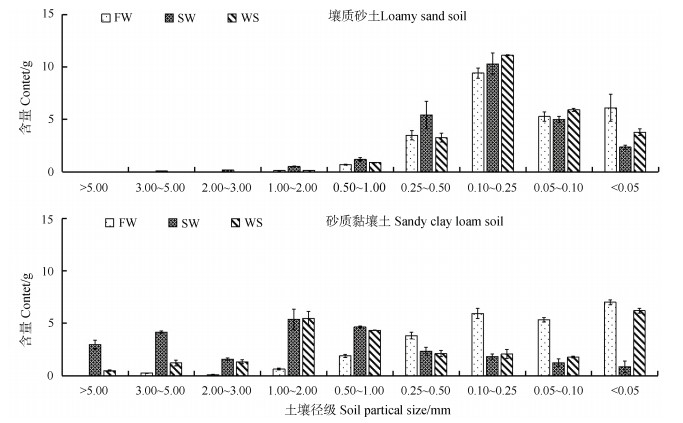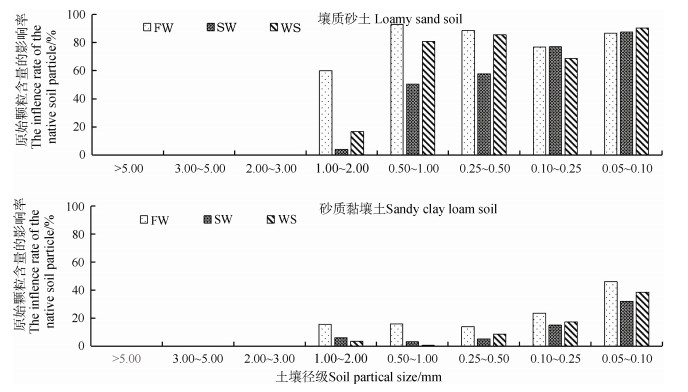2. 三峡库区生态环境教育部工程研究中心, 湖北宜昌 443002
2. Engineering Research Center of Eco-environment in Three Gorges Reservoir Region, Ministry of Education, China Three Gorges University, Yichang, Hubei 443002, China
土壤团聚体是土壤小颗粒通过凝聚胶结等作用形成的土壤结构基本单元[1]。团聚体为土壤养分贮存提供载体,为各种土壤微生物提供生境,常视作土壤结构的物质基础与土壤肥力的载体[2-6]。
消散作用、机械外力作用、土壤矿物湿润后非均匀膨胀作用和物理化学驱散作用是水分对团聚体的四种破坏机制,其中物理化学驱散作用在前三种作用破坏时均存在,而且对各作用的影响是相似的[7]。消散作用是团聚体浸没于水中或在暴雨时内部空气受到压缩对团聚体破坏作用,它是造成团聚体破坏的主要因素[8]。机械外力作用是团聚体受到雨滴打击或在运输过程中发生撞击由外部力的作用对团聚体造成破坏,是造成湿润团聚体破坏的主要原因[9]。土壤矿物湿润后非均匀膨胀作用是团聚体受到小雨时干湿循环过程中土壤黏粒矿物发生膨胀收缩产生的破坏作用[10]。
团聚体稳定性是描述其抵抗外力破坏作用的重要指标。分析团聚体粒径分布是计算团聚体稳定性前提。目前有很多方法用于测定团聚体稳定性,但各方法均存在一定问题。除与筛网碰撞外,干筛法未考虑任何团聚体破坏机制,而湿筛法则仅仅考虑了团聚体的消散破坏作用[11-12]。渗透稳定性主要通过在固定水头下测定放于固定圆筒中的10.00 g粒径为1.00~2.00 mm团聚体在一定时间内渗透的水量,来衡量团聚体稳定性,这种方法也仅仅考虑了消散作用对团聚体稳定性的影响[13]。雨滴打击法通过测定造成湿润团聚体破坏所需的雨滴数来衡量其稳定性,仅考虑了团聚体的机械外力破坏作用[14]。LB法(Le Bissonnais)是目前国际标准化组织测定团聚体稳定性的标准方法,它采用快速湿润、预湿润后震荡以及慢速湿润三种处理方式对团聚体进行预处理,考虑了团聚体的破碎机制[7, 15]。但LB法只选取了5 g粒径为3.00~5.00 mm的土壤团聚体进行研究,而此粒径范围的土壤团聚体能否有效反应整个土壤团聚体稳定性却无法验证。此外,所有这些方法均未考虑将土壤原始颗粒从各径级的团聚体中剥离出来,而将各径级范围的土壤原始颗粒视为土壤团聚体,这显然有悖于土壤团聚体的概念,也会影响团聚体稳定的结果。
因此,本文通过构建一种新的团聚体测定方法,模拟全土样团聚体不同破碎机制并考虑土壤原始颗粒的影响。以两种团聚体特征差异明显的土壤进行试验,分析土壤原始颗粒对不同破碎机制下团聚体稳定性的影响。本研究对深入理解土壤团聚体破坏机理,评价团聚体稳定性具有重要意义。
1 材料与方法 1.1 试验用土本研究选择壤质砂土(陕西神木县坡耕地)和砂质黏壤土(湖北秭归县新垦桔园地)两种不同质地土壤为研究对象。为提高样点代表性且减少空间变异性,在两个区域内选取土壤质地相同的3个样方(5m×5m),在每个样方内按照S形取样法,除去表层枯枝落叶后采集5个深度为0~20.00 cm的原状土样,混合。土样自然风干后人工剔除小石子及根系等杂质,过10.00 mm筛备用。土壤基本理化性质见表 1。本研究采用TopSizer激光粒度分析仪(SCF-108,珠海欧美克仪器公司,中国)扫描法测定土壤颗粒体积分数(国际制),重铬酸钾氧化外加热法测定有机质含量。
|
|
表 1 试验用土基本理化性质 Table 1 Basic physical-chemical properties of the experimental soils |
本研究参考国际标准#10930法[15]中LB法所采取的快速湿润、慢速湿润和预湿润振荡三种处理方式分别模拟消散作用、土壤矿物湿润后非均匀膨胀作用和机械外力作用对团聚体的破坏。选取约25.00 g全样土壤分别进行快速湿润、慢速湿润和预湿润振荡处理以避免LB法中3.00~5.00 mm粒径土壤团聚体能否有效反应整个土壤团聚体稳定性的问题。同时,为了消除土壤原始颗粒对各粒径的团聚体的影响,对各粒径土壤颗粒分别使用双氧水去除有机质并使用六偏磷酸钠进行分散以获取各粒径中存在的土壤原始颗粒。具体操作步骤如下:
(1)控制不同土壤含水率:将经处理的风干土壤置于40℃的烘箱内烘干48 h,以确保不同土壤各粒径团聚体初始含水率一致;
(2)进行团聚体不同破碎机制处理:将上述烘干后的土壤样品拿出烘箱并立即使用自封袋密闭,然后随机取土样25.00 g进行快速湿润、慢速湿润和预湿润振荡三种方式以分别模拟消散作用、土壤矿物湿润后非均匀膨胀作用和机械外力作用对团聚体的破坏。快速处理步骤为:取25 g土壤完全浸没在盛有250 mL去离子水的1 000 mL烧杯中,10 min后使用移液管将多余水分吸掉;慢速湿润的过程为:取25.00 g土壤轻轻放置于张力为–0.30 kPa湿滤纸上,静置40~60 min,待土壤充分湿润;预湿润后震荡过程为:取25 g土壤完全浸没于盛有250 mL酒精的1 000 mL锥形瓶中,10 min后吸掉酒精,加水至750 mL,然后用橡皮塞将锥形瓶口塞紧,上下震荡20次,静置20~40 min,待分散体沉淀后,用移液管吸去多余水分;
(3)对不同破碎机制预处理后的样品进行初筛:将处理后的样品转移至孔径为0.05 mm筛子中,浸没于质量浓度为95%酒精中,上下震荡20次(振幅2 cm),将保留在筛子中的土壤颗粒转移至烧杯中,在40℃温度烘箱内烘干48 h;
(4)初步筛分,获得不同粒径的“团聚体”:将步骤3中获得的不同破碎机制预处理后的初筛样品取出烘箱,依次分别过孔径为5.00 mm、3.00 mm、2.00 mm、1.00 mm、0.50 mm、0.25 mm、0.10 mm和0.05 mm筛,获取 > 5.00 mm、3.00~5.00 mm、2.00~3.00 mm、1.00~2.00 mm、0.50~1.00 mm、0.25~0.50 mm、0.10~0.25 mm和0.05~0.10 mm粒径“团聚体”。
(5)对不同粒径“团聚体”进行分散处理:分别对步骤4中对各粒径的“团聚体”加入双氧水去除颗粒中的有机质,采用六偏磷酸钠溶液作为分散剂进行分散,确保所有土壤颗粒均处于原始颗粒状态;
(6)将步骤5中经分散后的土壤颗粒在酒精浸没条件下过相应孔径的筛,将留在筛网上的土壤颗粒在40℃温度烘箱内烘干,分别获取各粒径土壤原始颗粒含量;
(7)将步骤4获取的各粒径的分散前土壤团聚体质量减去步骤6获取的对应粒径分散后土壤原始颗粒含量,得到各粒径下土壤纯团聚体含量;
(8)将步骤7获得的各粒径下土壤纯团聚体含量除以总土壤重量得到各粒径下土壤团聚体百分比,用于分析团聚体稳定性,完成土壤团聚体的测定。
1.3 数据处理团聚体稳定性采用平均重量直径(Mean Weight Diameters,MWD,mm)表示,分别采用MWDfw、MWDws、MWDsw表示快速湿润、湿润后机械震荡和缓慢湿润3种处理下团聚体稳定性。不同处理中,MWD数值越小表示团聚体稳定性越低,该处理对团聚体的破碎作用越大[16]。MWD采用文献[17]中公式计算。
纯团聚体含量为上述步骤4中获得的“团聚体”含量减去消散后的土壤原始颗粒含量,采用式(1)计算:
| $ {m_i}{\rm{ = }}{m_{ia}}{\rm{ - }}{m_{ip}} $ | (1) |
式中,mi表示考虑i粒径的纯土壤团聚体含量(g),mia表示i粒径未消除土壤原始颗粒的“团聚体”含量(g),mip表示i粒径中土壤原始颗粒含量(g)。
采用分散后各粒径中土壤原始土壤颗粒含量占未消除土壤原始颗粒的“团聚体”含量的百分比,以分析土壤原始颗粒对各径级团聚体含量的影响。计算公式如下:
| $ {r_i}{\rm{ = }}{{{m_{ia}}} / {{m_i}}}$ | (2) |
式中,ri表示i径级中土壤原始颗粒含量的影响率。
采用对比分散前后团聚体(> 0.05 mm)占总土壤的百分比(AR)评估土壤原始颗粒对土壤团聚体的影响。AR值越大,表明 > 0.05 mm粒径团聚体含量越多,分散前后AR差异越大,表明原始颗粒对团聚体的影响程度越大。团聚体(> 0.05 mm)占总土壤的百分比计算公式如下:
| $ AR{\rm{ = }}{{{m_{ > 0.05}}} / {{m_{\rm{t}}}}} $ | (3) |
式中,AR表示团聚体占总土壤的百分比(%),m > 0.05表示大于0.05 mm粒径团聚体含量(g),mt表示总土壤含量(g)。
2 结果与讨论 2.1 消除土壤原始颗粒影响前后不同处理方式下土壤粒径分布特征两种土壤在不同处理方式下,各粒径含量存在较大差异(图 1)。壤质砂土呈单峰分布,主要分布在0.05~0.50 mm范围内,约占土样总量80%,在3种处理方式下0.10~0.25 mm粒径含量最多,约占土样总量的40%,快速湿润和湿润后机械震荡两种处理模式下 > 2.00 mm粒径和慢速湿润模式下 > 3.00 mm粒径各筛网含量均为0。砂质黏壤土除快速湿润处理在 > 5.00 mm粒径含量为0外,其他各处理及各粒径中均有土壤存在,其中慢速湿润和湿润后机械震荡两种处理下1.00~2.00 mm粒径含量最多,而在快速湿润处理模式下主要为 < 0.05 mm粒径土壤颗粒,这表明快速湿润处理能够将土壤团聚体破碎更充分,形成更多小粒径土壤颗粒。同时,砂质黏壤土在慢速湿润处理下在 > 2.00 mm粒径含量明显大于湿润后机械震荡处理,表明慢速湿润处理对土壤团聚体破坏小于湿润后机械震荡处理。

|
注:FW,快速湿润;WS,预湿润后震荡;SW,慢速湿润 Note: FW, fast wetting; WS, mechanical breakdown by shaking after pre-wetting; SW, slow wetting 图 1 消除土壤原始颗粒影响前不同破碎机制下土壤粒径分布特征 Fig. 1 Particle size distribution of the soil before removal of influence of native soil particles relative to breaking-down mechanism |
两种土壤在不同处理模式下MWD也存在较大差异(表 2)。砂质黏壤土在三种处理模式下MWD均显著大于壤质砂土,这与砂质黏壤土黏粒含量和有机质含量均大于壤质砂土有关,黏粒和有机质均可以作为胶结物质形成更稳定的团聚体[17, 18]。总体而言,MWD呈现MWDfw < MWDws < MWDsw的大小顺序,这表明这两种土壤团聚体破坏均是快速湿润时孔隙内部封闭的空气压力作用为主,其次是机械外力作用,黏粒膨胀作用影响最小,这与其他学者采用LB法所测结果一致[19, 20]。壤质砂土快速湿润处理和湿润后机械震荡处理下MWD无显著性差异,两者均与慢速湿润处理下MWD呈显著性差异,这与壤质砂土结构较差,与湿润后机械震荡处理下土壤团聚体基本破碎有关。砂质黏壤土三种处理模式下MWD均存在显著性差异,砂质黏壤土结构本身较好,因此各处理模式下团聚体破碎程度均受到各破碎机制作用强度影响。
|
|
表 2 消除土壤原始颗粒影响前不同破碎机制下团聚体平均重量直径 Table 2 MWD before eliminating the influence of original soil particles relative to treatment |
不同土壤和不同处理方式下土壤原始颗粒对各径级团聚体影响差异较大(图 2)。整体而言,土壤原始颗粒影响2.00 mm以下粒径,这与土壤原始颗粒本身均小于2.00 mm有关。对壤质砂土而言,土壤原始颗粒除对SW处理1.00~2.00 mm径级的影响仅为4.00%外,对其他各处理下各粒径影响程度均大于50.00%,影响最大的为FW处理下0.50~1.00 mm粒径,达到92.75%。对砂质黏壤土而言,土壤原始颗粒对各破碎机制下所有径级的影响均小于50.00%,影响最大的为FW处理下0.05~0.01 mm粒径,为45.98%。这表明土壤原始颗粒对壤质砂土各径级的影响远大于砂质黏壤土。

|
注:FW,快速湿润;WS,预湿润后震荡;SW,慢速湿润。 Note: FW, fast wetting; WS, mechanical breakdown by shaking after pre-wetting; SW, slow wetting. 图 2 不同破碎机制下土壤原始颗粒不同各径级团聚体含量的影响率 Fig. 2 Influence of native soil particles on soil aggregates particle size distribution relative to treatment |
在小于2.00 mm粒径范围内,FW处理下土壤原始颗粒对壤质砂土和砂质黏壤土各径级团聚体的影响分别为60.00%~92.75%和13.83%~45.98%,平均值分别为80.95%和22.97%;SW处理模式下土壤原始颗粒对壤质砂土和砂质黏壤土各径级团聚体的影响分别为4.00%~87.43%和3.00%~32.00%,平均值分别为55.32%和12.19%;WS处理模式下土壤原始颗粒对壤质砂土和砂质黏壤土各径级团聚体的影响分别为16.67%~90.36%和0.46%~38.42%,平均值分别为68.41%和13.63%。壤质砂土中,土壤原始颗粒对1.00~2.00 mm、0.50~1.00 mm以及0.25~0.50 mm径级下影响程度依次为FW > WS > SW,而在0.10~0.25 mm和0.05~0.10 mm径级下三种破碎机制下影响程度差异不大,表明对于团聚体稳定性较差的土壤而言,不同破碎机制对微团聚体的破碎程度相近,而大团聚体受不同破碎机制影响较大。砂质黏壤土中,土壤原始颗粒对1.00~2.00 mm和0.50~1.00 mm粒径下影响依次为FW > SW > WS,而在0.25~0.50 mm、0.10~0.25 mm和0.05~0.10 mm粒径下影响较大时依次为FW > WS > SW,整体而言,土壤原始颗粒对FW处理影响最大,WS处理次之,而SW处理影响最小,这与FW处理时消散作用对团结体破碎作用较大,能够将土壤中更多团聚体完全破碎,而SW处理时仅土壤黏粒矿物发生膨胀收缩产生的破坏作用较小有关。这表明对于团聚体稳定性较好的土壤而言,土壤原始颗粒对不同破碎机制下各径级均有较大影响。
2.3 土壤原始颗粒对土壤团聚体的影响壤质砂土分散前AR在FW处理(不显著)和WS处理(显著)大于砂质黏壤土相应分散前的AR值,而在SW处理下则显著小于砂质黏壤土分散前AR值,这与上述砂质黏壤土在各处理条件下团聚体稳定性大于壤质砂土的结果不一致,表明受到土壤原始颗粒影响,分散前的AR值难以正确反映土壤团聚体稳定性。砂质黏壤土分散后的AR值在3种处理均显著大于壤质砂土,这与上述砂质黏壤土在各处理条件下团聚体稳定性大于壤质砂土的结果一致,表明消除土壤原始颗粒影响后,AR能够较好地体现土壤纯团聚体稳定性。
分散前后团聚体(> 0.05 mm)占总土壤的百分比AR两个土壤在各处理模式下均存在显著性差异(表 3),这表明土壤原始颗粒对土壤团聚体影响巨大。壤质砂土分散前AR在FW、SW和WS处理下分别为分散后AR的5.65倍、3.43倍和4.50倍,而砂质黏壤土分散前AR在FW、SW和WS处理下分别为分散后AR的1.36倍、1.05倍和1.08倍,这表明土壤原始颗粒对壤质砂土的影响远远大于砂质黏壤土。两种土壤分散前后AR比均表现为FW > WS > SW,这表明土壤原始颗粒对FW处理影响最大,WS处理影响次之,SW处理影响最小。
|
|
表 3 不同破碎机制下分散前后团聚体(> 0.05 mm)占总土壤的百分比 Table 3 Proportions of soil aggregates(> 0.05 mm)to the total soil before and after eliminating the influence of native soil particles relative to treatment |
本研究以两种不同质地团聚体特征差异明显的壤质砂土和砂质黏壤土为研究对象,通过使用全土样进行快速湿润、慢速湿润和预湿润振荡处理对土壤团聚体进行破碎。使用双氧水去除有机质并使用六偏磷酸钠进行分散以获取各径级中存在的土壤原始颗粒,研究土壤原始颗粒对不同破碎机制下团聚体稳定性的影响。得到如下结论:两种土壤在不同处理方式下,各径级含量存在较大差异。壤质砂土在0.05~0.50 mm范围径级含量达80%左右,砂质黏壤土SW和WS两种处理模式下在1.00~2.00 mm径级含量最多,而FW处理则主要存在于 < 0.05 mm径级中。砂质黏壤土在三种处理模式下MWD均显著大于壤质砂土,且两种土壤MWDfw < MWDws < MWDsw,这表明这两种土壤团聚体破坏均是孔隙内部封闭的空气压力作用为主,其次是机械扰动作用,黏粒膨胀作用影响最小。不同土壤和不同处理方式下土壤原始颗粒对各径级团聚体影响程度差异较大。对壤质砂土而言,除了SW处理模式下1.00~2.00 mm径级的影响仅为4%外,其他各处理均大于50%,而对砂质黏壤土各处理的影响程度均小于50%。土壤原始颗粒对各径级团聚体的影响程度受到土壤类型和破碎机制影响。分散前的AR值难以正确反映土壤团聚体稳定性,消除土壤原始颗粒影响后,AR能够较好的体现土壤团聚体稳定性。土壤原始颗粒对壤质砂土的影响远远大于对砂质黏壤土的影响,壤质砂土分散前AR在FW、SW和WS处理下分别为分散后AR的5.65倍、3.43倍和4.50倍,而砂质黏壤土分别是1.36倍、1.05倍和1.08倍,差异显著。
| [1] |
Six J, Bossuyt H, Degryze S, et al. A history of research on the link between(micro) aggregates, soil biota, and soil organic matter dynamics[J]. Soil and Tillage Research, 2004, 79(1): 7-31. DOI:10.1016/j.still.2004.03.008
(  0) 0) |
| [2] |
Ju X N, Jia Y H, Gan M, et al. Characteristics of soil macropores in the gully area of loess plateau as affected by terrain (In Chinese)[J]. Acta Pedologica Sinica, 2018, 55(5): 1098-1107. [鞠忻倪, 贾玉华, 甘淼, 等. 黄土沟壑区不同地形部位土壤大孔隙特征研究[J]. 土壤学报, 2018, 55(5): 1098-1107.]
(  0) 0) |
| [3] |
Wang J X, Pan Y Z, Zhu X F, et al. A review of researches on inversion of eigenvariance of soil water (In Chinese)[J]. Acta Pedologica Sinica, 2019, 56(1): 23-35. [王俊霞, 潘耀忠, 朱秀芳, 等. 土壤水分反演特征变量研究综述[J]. 土壤学报, 2019, 56(1): 23-35.]
(  0) 0) |
| [4] |
Liu M Y, Wu J L, Liu L W, et al. Stability characteristics of soil water-stable aggregates under different land-use patterns on the loess plateau (In Chinese)[J]. Journal of Natural Resources, 2016, 31(9): 1564-1576. [刘梦云, 吴健利, 刘丽雯, 等. 黄土台塬土地利用方式对土壤水稳性团聚体稳定性影响[J]. 自然资源学报, 2016, 31(9): 1564-1576.]
(  0) 0) |
| [5] |
Yan J H, Zhang F H, Tan B, et al. Effects of reclamation history of deserted salinized farmlands on organic carbon composition and aggregate stability of the soils (In Chinese)[J]. Acta Pedologica Sinica, 2013, 50(6): 1180-1190. [闫靖华, 张凤华, 谭斌, 等. 不同恢复年限对土壤有机碳组分及团聚体稳定性的影响[J]. 土壤学报, 2013, 50(6): 1180-1190.]
(  0) 0) |
| [6] |
Lu M Z, Lü X G, Guan Q, et al. Advancement in study on effect of earthworm on greenhouse gas emission in soil and its mechanism (In Chinese)[J]. Acta Pedologica Sinica, 2015, 52(6): 1209-1225. [卢明珠, 吕宪国, 管强, 等. 蚯蚓对土壤温室气体排放的影响及机制研究进展[J]. 土壤学报, 2015, 52(6): 1209-1225.]
(  0) 0) |
| [7] |
Le Bissonnais Y. Aggregate stability and assessment of soil crustability and erodibility: I. Theory and methodology[J]. European Journal of Soil Science, 1996, 47(4): 425-437. DOI:10.1111/j.1365-2389.1996.tb01843.x
(  0) 0) |
| [8] |
Auerswald K. Percolation stability of aggregates from arable topsoils[J]. Soil Science, 1995, 159(2): 142-148. DOI:10.1097/00010694-199502000-00009
(  0) 0) |
| [9] |
Shi Z H, Yan F L, Li Z X, et al. Effects of topsoil aggregate dispersion on runoff and erosion at hillslope in red soils (In Chinese)[J]. Progress in Natural Science, 2007, 17(2): 217-224. [史志华, 闫峰陵, 李朝霞, 等. 红壤表土团聚体破碎方式对坡面产流过程的影响[J]. 自然科学进展, 2007, 17(2): 217-224.]
(  0) 0) |
| [10] |
Guo W, Shi Z H, Chen L D, et al. Effects of topsoil aggregate size on runoff and erosion at hillslope in red soils (In Chinese)[J]. Acta Ecologica Sinica, 2007, 27(6): 2516-2522. DOI:10.3321/j.issn:1000-0933.2007.06.046 [郭伟, 史志华, 陈利顶, 等. 红壤表土团聚体粒径对坡面侵蚀过程的影响[J]. 生态学报, 2007, 27(6): 2516-2522.]
(  0) 0) |
| [11] |
Almajmaie A, Hardie M, Acuna T, et al. Evaluation of methods for determining soil aggregate stability[J]. Soil and Tillage Research, 2017, 167: 39-45. DOI:10.1016/j.still.2016.11.003
(  0) 0) |
| [12] |
Li J, Yang X Y, Sun B H, et al. Effects of soil management practices on stability and distribution of aggregates in Lou soil (In Chinese)[J]. Journal of Plant Nutrition and Fertilizer, 2014, 20(2): 346-354. [李婕, 杨学云, 孙本华, 等. 不同土壤管理措施下塿土团聚体的大小分布及其稳定性[J]. 植物营养与肥料学报, 2014, 20(2): 346-354.]
(  0) 0) |
| [13] |
Ma L Y, Xu M X, Li B B, et al. Evaluation of water stability of soil aggregates with different particle-sizes based on quality and quantity methods (In Chinese)[J]. Journal of Northwest A & F University(Natural Science Edtion), 2019, 47(2): 126-134. [马露洋, 许明祥, 李彬彬, 等. 基于质量和数量方法的不同粒径土壤团聚体水稳性评价[J]. 西北农林科技大学学报(自然科学版), 2019, 47(2): 126-134.]
(  0) 0) |
| [14] |
Mbagwu J S C, Auerswald K. Relationship of percolation stability of soil aggregates to land use, selected properties, structural indices and simulated rainfall erosion[J]. Soil and Tillage Research, 1999, 50(3/4): 197-206.
(  0) 0) |
| [15] |
ISO/DIS 10930. Soil quality-measurement of the stability of soil aggregates subjected to the action of water. International Organization for Standardization Geneva, Switzerland. 2012.
(  0) 0) |
| [16] |
Jimba S C, Lowery B. Automation of the water-drop method for soil aggregate stability analysis[J]. Soil Science Society of America Journal, 2010, 74(1): 38-41. DOI:10.2136/sssaj2009.0023N
(  0) 0) |
| [17] |
Zeng Q C, Dong Y H, Li X, et al. Soil aggregate stability and erodibility under forest vegetation in the Loess Plateau using the Le Bissonnais method (In Chinese)[J]. Chinese Journal of Eco-Agriculture, 2014, 22(9): 1093-1101. [曾全超, 董扬红, 李鑫, 等. 基于Le Bissonnais法对黄土高原森林植被带土壤团聚体及土壤可蚀性特征研究[J]. 中国生态农业学报, 2014, 22(9): 1093-1101.]
(  0) 0) |
| [18] |
Wang Z L, Hu F N, Zhao Y G, et al. Distribution characteristics of soil cementing material and its effect on loess macro-aggregate stability (In Chinese)[J]. Journal of Soil and Water Conservation, 2016, 30(5): 331-336. [王子龙, 胡斐南, 赵勇钢, 等. 土壤胶结物质分布特征及其对黄土大团聚体稳定性的影响[J]. 水土保持学报, 2016, 30(5): 331-336.]
(  0) 0) |
| [19] |
Yan F L, Li Z X, Shi Z H, et al. Quantitative relationship between aggregate characteristics of red soil and slope erosion (In Chinese)[J]. Transactions of the Chinese Society of Agricultural Engineering, 2009, 25(3): 37-41. [闫峰陵, 李朝霞, 史志华, 等. 红壤团聚体特征与坡面侵蚀定量关系[J]. 农业工程学报, 2009, 25(3): 37-41.]
(  0) 0) |
| [20] |
Xiao H, Liu G, Liu P L, et al. Developing equations to explore relationships between aggregate stability and erodibility in Ultisols of subtropical China[J]. Catena, 2017, 157: 279-285.
(  0) 0) |
 2021, Vol. 58
2021, Vol. 58


